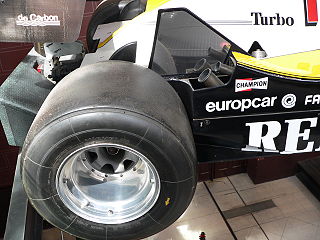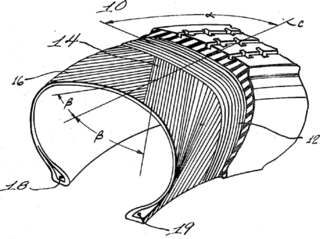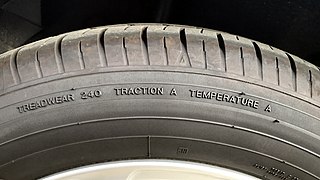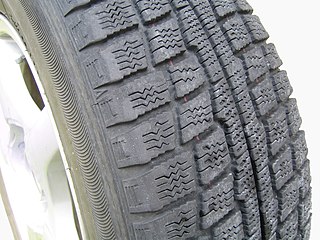
A tire or tyre is a ring-shaped component that surrounds a wheel's rim to transfer a vehicle's load from the axle through the wheel to the ground and to provide traction on the surface over which the wheel travels. Most tires, such as those for automobiles and bicycles, are pneumatically inflated structures, which also provide a flexible cushion that absorbs shock as the tire rolls over rough features on the surface. Tires provide a footprint, called a contact patch, that is designed to match the weight of the vehicle with the bearing strength of the surface that it rolls over by providing a bearing pressure that will not deform the surface excessively.

Michelin, in full Compagnie Générale des Établissements Michelin SCA, is a French multinational tyre manufacturing company based in Clermont-Ferrand in the Auvergne-Rhône-Alpes région of France. It is the second largest tyre manufacturer in the world behind Bridgestone and larger than both Goodyear and Continental. In addition to the Michelin brand, it also owns the Kléber tyres company, Uniroyal-Goodrich Tire Company, SASCAR, Bookatable and Camso brands. Michelin is also notable for its Red and Green travel guides, its roadmaps, the Michelin stars that the Red Guide awards to restaurants for their cooking, and for its company mascot Bibendum, colloquially known as the Michelin Man, who is a humanoid consisting of tyres.

A racing slick or slick tyre is a type of tyre that has a smooth tread used mostly in auto racing. The first production slick tyre was developed by M&H Tires in the early 1950s for use in drag racing. By eliminating any grooves cut into the tread, such tyres provide the largest possible contact patch to the road, and maximize dry traction for any given tyre dimension; see Performance. Slick tyres are used on race tracks and in road racing, where acceleration, steering and braking require maximum traction from each wheel. Slick tyres are typically used on only the driven (powered) wheels in drag racing, where the only concern is maximum traction to put power to the ground, and are not used in rallying.

The tread of a tire or track refers to the rubber on its circumference that makes contact with the road or the ground. As tires are used, the tread is worn off, limiting its effectiveness in providing traction. A worn tire can often be retreaded.

The Tweel is an airless tire design developed by the French tire company Michelin. Its significant advantage over pneumatic tires is that the Tweel does not use a bladder full of compressed air, and therefore cannot burst, leak pressure, or become flat. Instead, the Tweel's hub is connected to the rim via flexible polyurethane spokes which fulfil the shock-absorbing role provided by the compressed air in a traditional tire.

A radial tire is a particular design of vehicular tire. In this design, the cord plies are arranged at 90 degrees to the direction of travel, or radially. Radial tire construction climbed to 100% market share in North America following Consumer Reports finding the superiority of the radial design in 1968, and were standard by 1976.
Cooper Tire & Rubber Company is an American company that specializes in the design, manufacture, marketing, and sales of replacement automobile and truck tires, and has subsidiaries that specialize in medium truck, motorcycle, and racing tires. With headquarters in Findlay, Ohio, Cooper Tire has 60 manufacturing, sales, distribution, technical, and design facilities within its worldwide family of subsidiary companies, including the UK-based Avon Tyres brand, which produces tires for motorcycles, road cars, and race cars.

Snow chains, or tire chains, are devices fitted to the tires of vehicles to provide increased traction when driving through snow and ice.

Siping is a process of cutting thin slits across a rubber surface to improve traction in wet or icy conditions.

Uniform Tire Quality Grading, commonly abbreviated as UTQG, is the term encompassing a set of standards for passenger car tires that measures a tire's treadwear, temperature resistance and traction. The UTQG was created by the National Highway Traffic Safety Administration in 1978, a branch of the United States Department of Transportation (DOT). All tires manufactured for sale in the United States since March 31, 1979 are federally mandated to have the UTQG ratings on their sidewall as part of the DOT approval process, in which non-DOT approved tires are not legal for street use in the United States. It is not to be confused with the tire code, a supplemental and global standard measuring tire dimensions, load-bearing ability and maximum speed, maintained by tire industry trade organizations and the International Organization for Standardization.
A run-flat tire is a pneumatic vehicle tire designed to resist the effects of deflation when punctured, allowing the vehicle to continue to be driven at reduced speeds for limited distances. First developed by tire manufacturer Michelin in the 1930s, run-flat tires were introduced to the public market in the 1980s. They have increased in popularity over time.

Automotive tires are described by an alphanumeric tire code or tyre code, which is generally molded into the sidewall of the tire. This code specifies the dimensions of the tire, and some of its key limitations, such as load-bearing ability, and maximum speed. Sometimes the inner sidewall contains information not included on the outer sidewall, and vice versa.

Pneumatic tires are manufactured according to relatively standardized processes and machinery, in around 455 tire factories in the world. With over 1 billion tires manufactured worldwide annually, the tire industry is a major consumer of natural rubber. Tire factories start with bulk raw materials such as synthetic rubber, carbon black, and chemicals and produce numerous specialized components that are assembled and cured.
Nokian Tyres plc, headquartered in Nokia, Finland, produces tyres for cars, trucks, buses, and heavy-duty equipment. Known for its winter tyres, Nokian is the only tyre manufacturer in the world with its own permanent winter tyre testing facility. The company's Hakkapeliitta brand name is recognised in Finland as a trademark.

Airless tires, non-pneumatic tires (NPT), or flat-free tires are tires that are not supported by air pressure. They can be used on small vehicles such as ride-on lawn mowers and motorized golf carts. They also are used on heavy equipment required to operate on sites where risk of tire punctures is high. Tires composed of closed-cell polyurethane foam are also made for bicycles and wheelchairs.

Snow tires, also known as winter tires, are tires designed for use on snow and ice. Snow tires have a tread design with larger gaps than those on conventional tires, increasing traction on snow and ice. Such tires that have passed a specific winter traction performance test are entitled to display a 3PMSF symbol on their sidewalls. Tires designed for winter conditions are optimized to drive at temperatures below 7 °C (45 °F). Studded tires are a type of snow tires which have metal or ceramic studs that protrude from the tire to increase traction on hard-packed snow or ice. Studs abrade dry pavement, causing dust and creating wear in the wheel path. Regulations that require the use of snow tires or permit the use of studs vary by country in Asia and Europe, and by state or province in North America.

A motorcycle tyre is the outer part of motorcycle wheel, attached to the rim, providing traction, resisting wear, absorbing surface irregularities, and allowing the motorcycle to turn via countersteering. The two tyres' contact patches are the motorcycle's connection to the ground, and so are fundamental to the motorcycle's suspension behaviour, and critically affect safety, braking, fuel economy, noise, and rider comfort.

The Tyre Label is a mark for motor vehicle tyres. Manufacturers of tyres for cars, light and heavy trucks must specify fuel consumption, wet grip and noise classification of every tyre sold in EU market starting in November 2012.

The following outline is provided as an overview of and topical guide to tires:

Bar grip tyres, or 'NDT' in US military parlance, are an early tyre tread pattern developed for off-road use.















